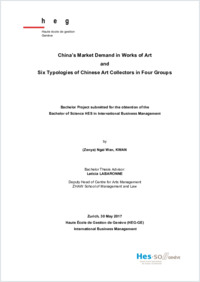China's market demand in works of art and six typologies of Chinese art collectors in four groups
SONAR|HES-SO
- Kwan, Ngai Wan
- Labaronne, Leticia (Degree supervisor)
-
2017
85 p.
Mémoire de bachelor: Haute école de gestion de Genève, 2017
English
The aim of the thesis is to analyze the external factors in shaping the development of art market in China. It investigates the growing market demand from a macroeconomic aspect such as political leadership and government policy. Then, it addresses the development of market supply specifically, Christie’s and Sotheby’s in entering the Chinese market. The finding of the thesis provides the six typologies of Chinese art collectors in four groups as recommendation to readers which they were compared with The Five Styles of Collecting (2016) put forward by Uli Sigg and The Three Layers of Chinese Collectors (2014) put forward by Alexendre Errera. Empirical analysis was conducted by semistructured interviews for collecting qualitative data. The interviews were one-to-one and face to face. Chosen interviewees were advisors, gallerists or auctioneers who are experienced in serving Chinese clients. The interviews covered four aspects: e.g. ‘who’ are they, ‘what’ do they buy, ‘why’ do they buy and ‘how’ to maintain positive relationships with Chinese collectors.The interviews were attached to the appendix ; thereafter, a transcript summary was produced which came in three dimensions, “The Art Market in China”, “Characteristic of Chinese Collectors” and “Result”.The younger group of collectors, Young & Worldly are at their 20s to 40s who speak English, have studied abroad and have better understanding of international standards than their elders. They are the 2nd or 3rd generations of tycoons and a majority of them is from finance or E-commerce industry. They collect all kind of contemporary art from Eastern to Western but Chinese traditional art. Collecting Western art represents the participation of Western life style and it has the symbolic meaning of being fashionable and successful. The older group of collectors is the first generation of self-made entrepreneurs. They were born and raised in China and likely do not speak English. They are at the age of 40 to 60 years old. They begin to collect with Chinese traditional art from the 1990s. Then, they merge into other categories of art. Nationalists only collect Chinese cultural relics including calligraphy, ceramics, antiques and imperial objects. The fulfilment in restoring national greatness and owning ‘a piece of history’ drive them to remain as this type of collectors. They are not interested in Western art; however, it is expected to be influenced by their children who study abroad or due to the market trend to collect Western Art. Super-Star Experimentalists only collect works from established artists and they prefer to buy at auction. They do not spend time on lesser known Cubists if they can afford Picasso’s painting. The demonstration of personal capability, wealth and power is the driving force for this type of collectors. The disappearing group of collectors, Flippy Investors have no age specification. Most Chinese investors have the mind-set to speculate instead of investing for the long-term. This speculative behaviour also exists in property and stock market in China. However, they begin to realize that art has fewer liquidation possibilities than other trading currency such as stocks and property. It is expected that the process of being inspired by art will grow them into art collectors. The future group of collectors, Influentialists are important art collectors who are just moving forward in making an impact in the art scene such as Adrian Cheng. Being an influentialist requires consistent contribution in truly making a different in the art scene. The satisfaction in seeing the development of their promoted artists is the drive force. However, there are still not many Chinese collectors in sponsoring academic awards at an institutional level. Whereas, their financial funds for art are mainly spend on their collection or to operate their private art museums. Systematists aim to create a new level of dialogue between each piece of artworks in the collection as their essential goal. It is the most complex form of collecting in which many Chinese collectors have yet to reach such level of maturity in collecting. At the moment, most chinese art collectors may have a great knowledge about the individual piece of art they bought. However, it is likely that they are lack of overall understanding in relating one to another.
- Language
-
- French
- Classification
- Economics
- Notes
-
- Haute école de gestion Genève
- International Business Management
- hesso:hegge
- License
-
License undefined
- Identifiers
-
- RERO DOC 306015
- RERO R008735930
- Persistent URL
- https://sonar.ch/global/documents/314734
Statistics
Document views: 131
File downloads:
- Mémoire: 374
